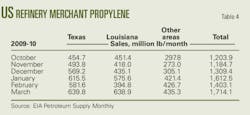Coming from Russia: more crude, lighter and sweeter
Russia has historically exported medium sour crude, but over the next decade there will be more than a 2 million b/d increase in light sweet exports. Several developments will bring about this transformation.
A geographic redistribution of Russian crude output, with new growth coming in such areas as East Siberia and Timan-Pechora, will reshape Russian output. Much of the new supply will be light sweet, while output of medium sour will decline.
Meanwhile, Russian export infrastructure will continue to develop in line with these internal shifts and Russian foreign economic objectives. Changes to the export infrastructure will enable more light sweet to reach the market without commingling with medium sour crude in the main pipeline system.
Growth of exports from Kazakhstan via Russia will also be significant. The transformation of Russian crude exports is already under way. The approaching launch of the East Siberia-Pacific Ocean (ESPO) pipeline and development of East Siberian fields will boost light sweet supply to Asia in 2010.
Based on an analysis and projections of production, consumption, and exports by Energy Security Analysis Inc., Russian crude oil output is projected to grow at an average rate of 0.3%/year through 2020, bringing output to nearly 10.2 million b/d.
The Russian government seeks to increase throughput of domestic refineries, which would undermine future crude exports. But there are reasons to believe that by 2020 throughput levels will actually decline. Based on an analysis of foreign and Russian fuel specifications, ESAI projects that lack of investment to equip refineries to supply quality products will force some Russian refiners to shut down. Russian oil product exports, mostly high-sulfur fuel oil and gas oil, will continue to become less competitive in traditional foreign markets.
European Union countries will continue to reduce Russian gas oil imports as their regional deficit declines and the availability of higher quality gas oil from the US increases. If there is a proliferation of emissions control areas for bunker fuel, exports of high-sulfur fuel oil will also become less competitive.
Russia is slowly moving to improve fuel quality on the domestic market, which will also reduce the viability of refineries that do not modernize. Russian and Commonwealth of Independent States refineries consumed 5.5 million b/d of Russian crude in 2008. ESAI presumes that number will fall to 4.6 million b/d in 2020, enabling Russia to export more crude oil.
In addition, ESAI assumes the launch of production at Kashagan oil field in the Caspian Sea will cause crude exports from Kazakhstan via Russia to rise from 950,000 b/d in 2008 to 1.3 million b/d in 2020. As a result of these trends, crude exports from Russia should rise to 6.6 million b/d in 2020 from 5.1 million b/d in 2008 (Table 1).
ESAI sees downside risks to Russian supply after 2020. For that reason, volumes will probably decline in the decade through 2030. It is very likely that 2020 will represent a peak in terms of Russian exports.
Exports to Europe
Russian light sweet crude exports to Europe will grow by 1 million b/d over the next decade. Meanwhile, outflows of medium sour will decrease. The trend toward greater light sweet exports will be shaped by several developments in Russia as well as by the growth of transit flows from Kazakhstan.
In northwestern Russia, Lukoil produces light sweet crude from South Khylchuya field in Timan-Pechora. ESAI estimates that the crude produced in Timan-Pechora and the Barents Sea will generally be light sweet, similar in quality to oil in the nearby North Sea.
ESAI assumes that future Russian supply from the Caspian Sea will also be light sweet. As already noted, growing volumes of Kazakh light sweet from Tengiz and Kashagan will feed into both the Caspian Pipeline Consortium and Transneft pipeline systems.
Meanwhile, Russia is developing oil export capacity via seaports, including the Black, Baltic, and Barents Seas in European Russia.
Based on plans for the expansion of CPC pipeline capacity to 1.34 million b/d (planned simultaneously with construction of the Burgas-Alexandroupolis pipeline), ESAI expects exports of Russian and Kazakh crude via the Black Sea will grow to 1.3 million b/d in 2020. Thus the lion’s share of Black Sea exports will be CPC Blend.
The expansion of the Baltic Pipeline System (work on BPS-2 officially began in June) will divert oil from the Druzhba pipeline system that is now used for overland supply of 1.25 million b/d to Central and Eastern Europe. ESAI estimates that exports through the Baltic Sea will grow to more than 2 million b/d by 2020, while the Druzhba pipeline will transport diminishing volumes.
These infrastructure changes will enable strong growth in the amount of light sweet crude exported independently of the Transneft pipeline system. ESAI projects that exports of light sweet crude (including transit volumes) will grow from 764,000 b/d in 2008 to 1.76 million b/d in 2020, while exports of medium sour will decrease from 3.7 million b/d in 2008 to an estimated 3.3 million b/d in 2020 (Table 2).
For Europe, growth of Russian light sweet exports will partially offset declining North Sea supply of light sweet. Additionally, when one combines the impacts of growing light sweet supply to the Transneft system with decline of heavy sour crude supply in the Volga region, the medium sour Urals blend exported from Russia will gradually become lighter and lower in sulfur.
Effects in Asia
Russia exported 212,000 b/d of light sweet crude from Sakhalin in 2008, so it is already a supplier of light sweet crude to Asia.
The first phase of the ESPO pipeline, to be completed by 2010, will provide up to 300,000 b/d by pipeline and rail to Kozmino Bay on the Pacific Ocean and another 300,000 b/d to China. The quality of crude from the main supply sources of the pipeline, Vankor and other East Siberian fields, will generally be light sweet.
Russia has a target to eventually raise capacity of the pipeline to 1.6 million b/d. Based on ESAI’s projections for growth of Russian output and likely demand for crude, this objective will not be reached. However, ESAI estimates that growth in supply via the ESPO pipeline will enable overall exports of light sweet crude to Asia to reach 1.3 million b/d by 2020 (Table 3).
Russian light sweet crude will be an attractive substitute for China’s declining output of medium sweet, especially for refiners that fail to invest in desulfurization capacity. China is just one important market where Russia will increase its market share.
The volume of oil supplied from Russia to Asia is not the only impact Russia will have on that market. ESPO Blend may become an important regional price benchmark. Buyers in Asia, eager to have an alternative price benchmark to Dubai, will support the establishment of independent price discovery and the creation of a spot market for ESPO Blend. Consequently, Russian exports to Asia may also influence regional pricing.
Different crude supplier
Russia will be a very different crude exporter in 2020, as the accompanying map illustrates.
Exports from Russian sea ports will climb from 3.4 million b/d now to 5.6 million b/d, enabling Russia to develop flexibility in its export targets, reach new markets, and expand economic influence. Exports to Asia will soar to at least 1.5 million b/d from less than 400,000 b/d in 2008. In Europe, growth of exports will be mainly associated with increased transit volumes from Kazakhstan.
Russia’s growth of light sweet production and the commingling of growing volumes of light sweet from Kazakhstan in the Russian export infrastructure will transform the quality of crude exports, making Russia a key supplier of both light sweet and medium sour qualities.
While ESAI expects 2020 to represent a peak in terms of the volume of crude exports, the trend of growing light sweet exports will continue. ESAI projects that by 2025 more than half of Russian crude exports will be light sweet.
The author





